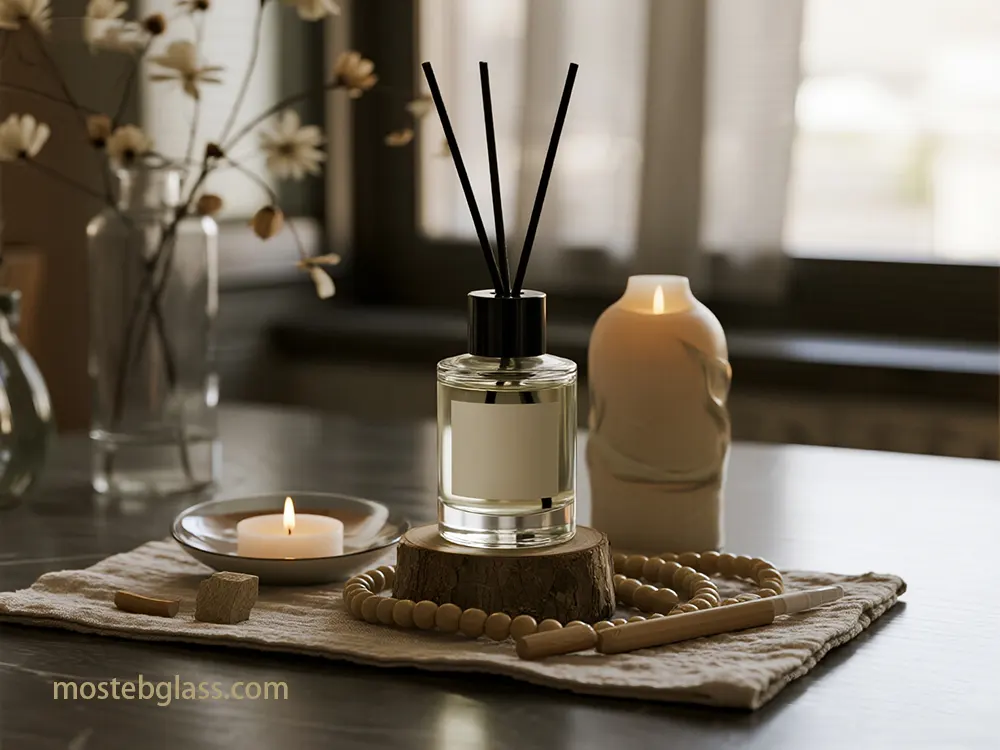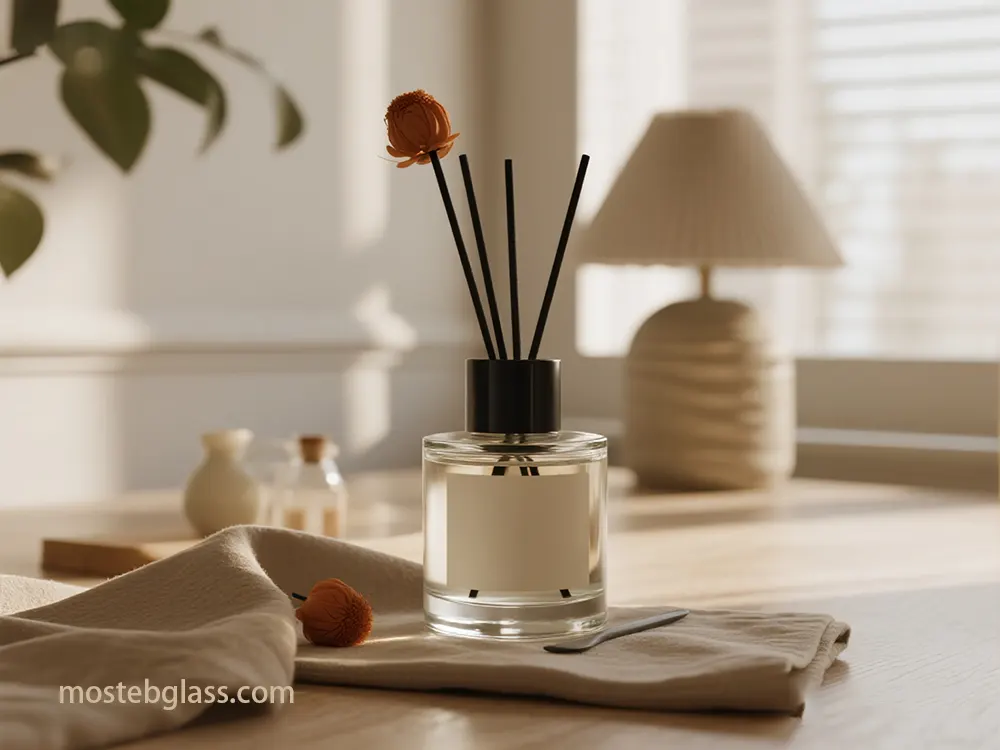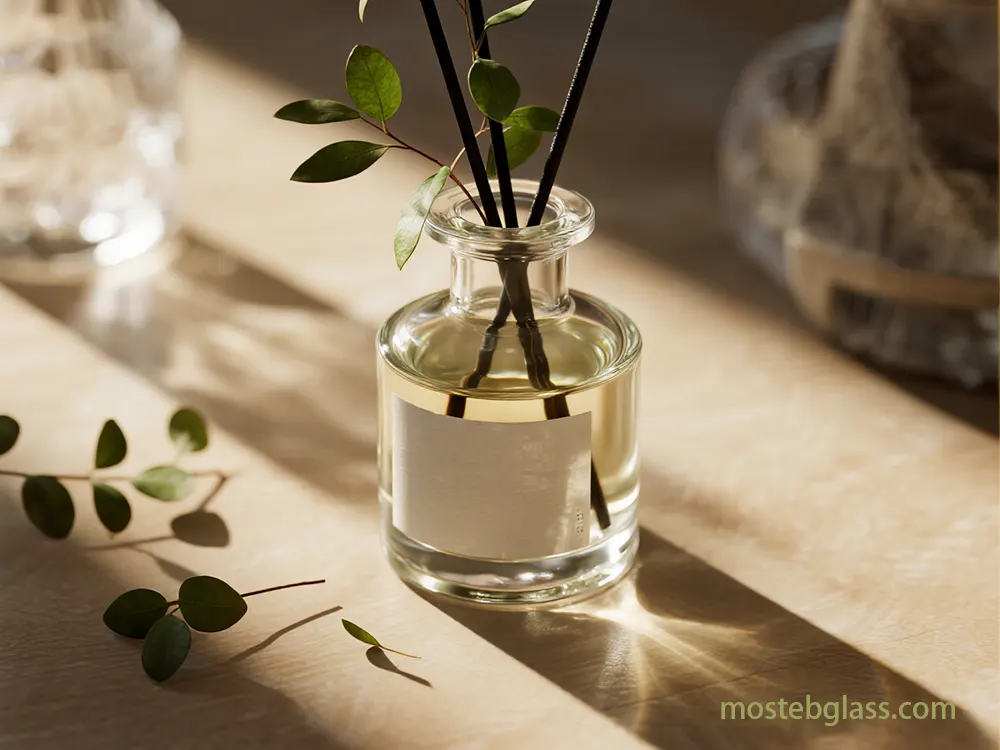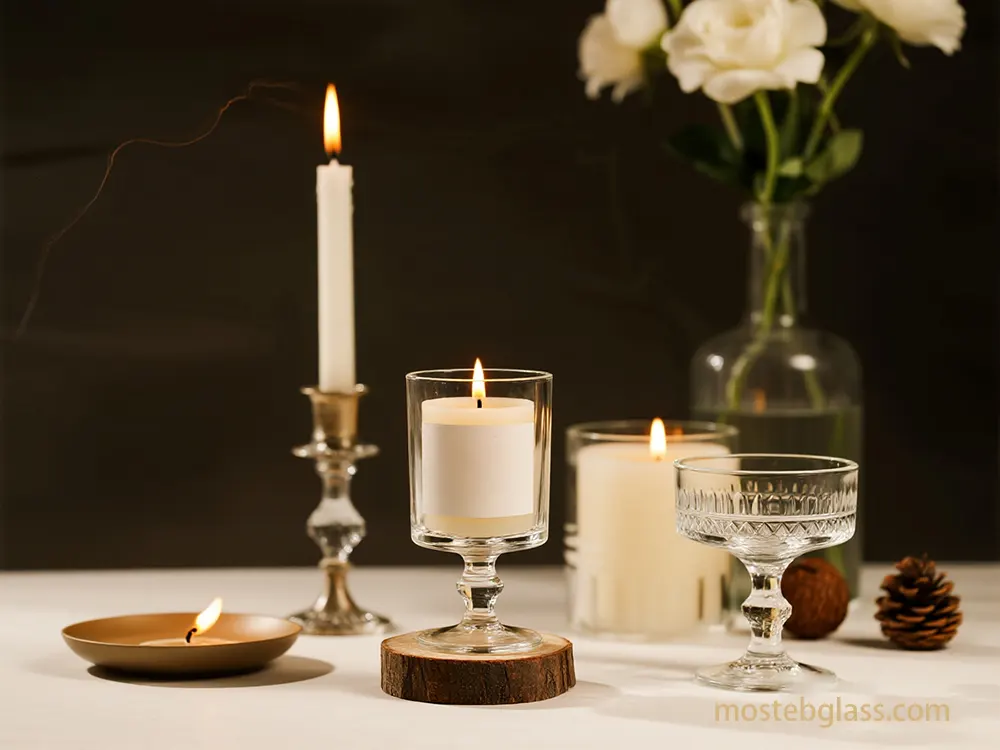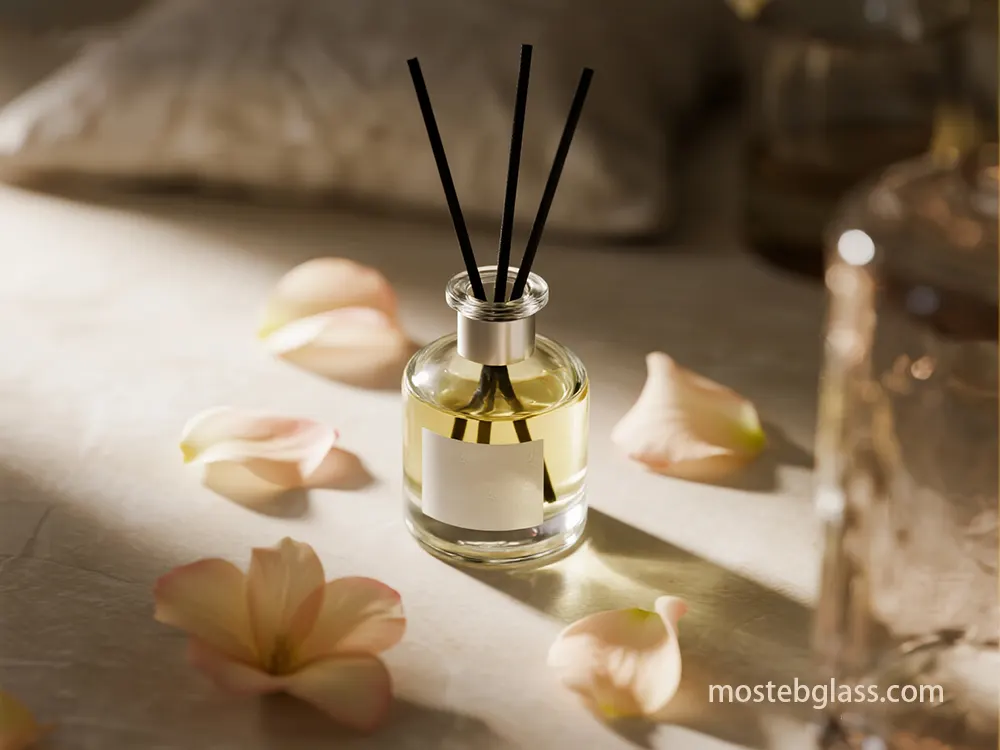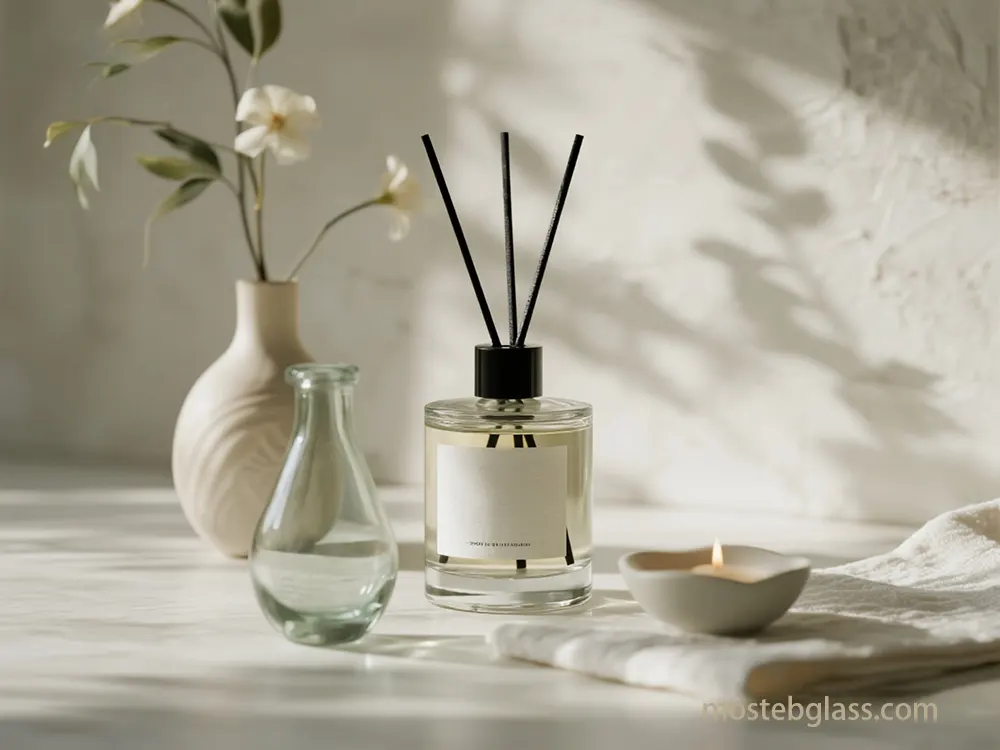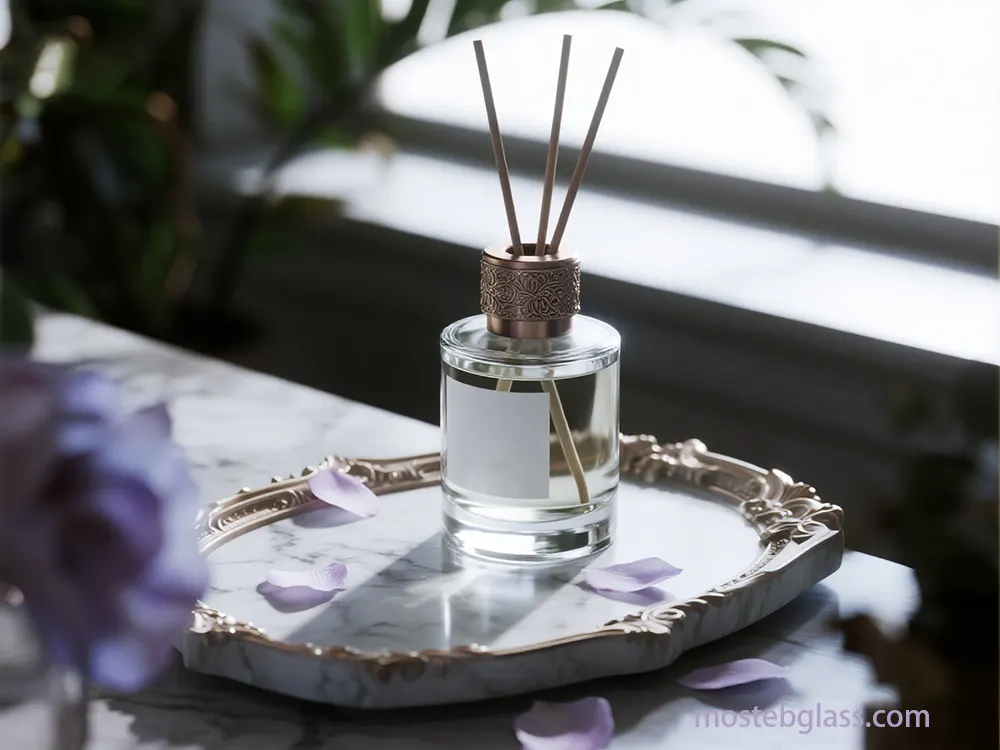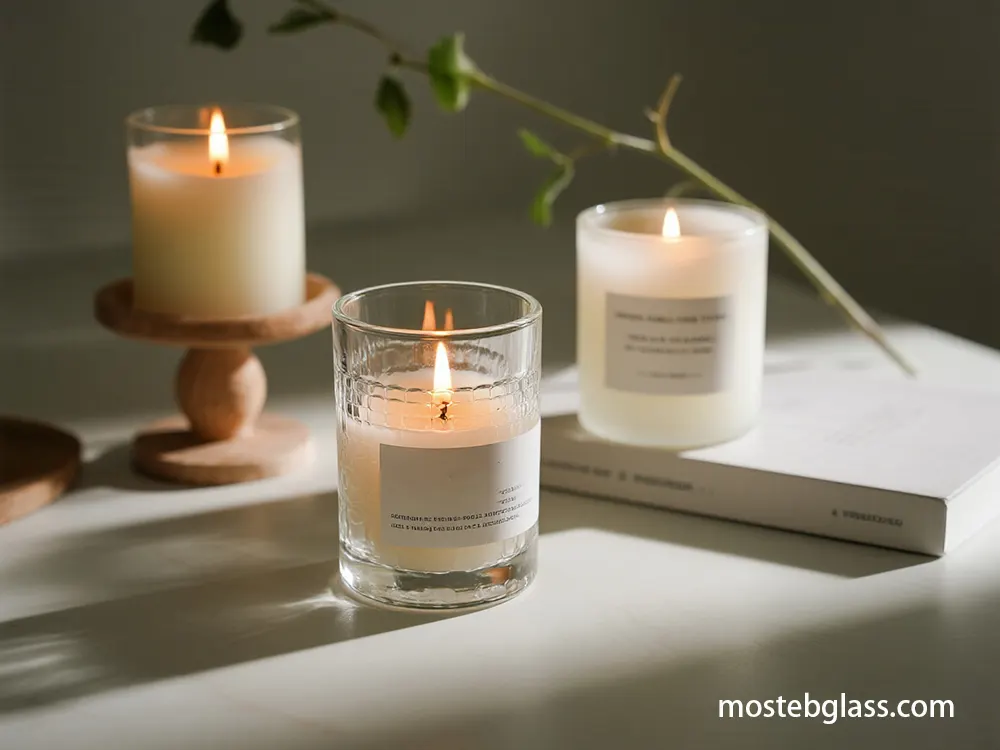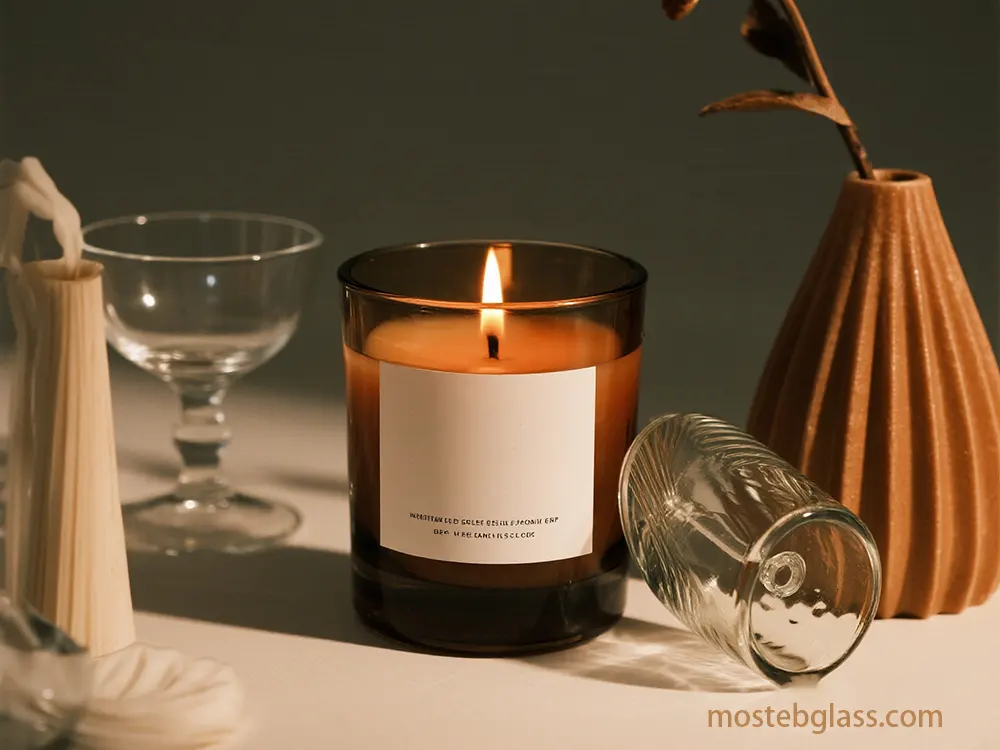Many brands use decorative glass to effectively tell their stories:
Hennessy Cognac
used Signature logo, gold lettering, thick walls, complex cork closures and smooth glass bottles with velvet pouches to emphasize luxury and traditional aesthetics.
Tom Ford’s Black Orchid Perfume
has ribbed glass bottles with a retro-futuristic design, engaged in a matte black box with gold details, creating a bhogi and modern luxury presentation.
Jo Malone London
appoints a cream and black palette, rigid boxes with grocegrain ribbon, and a softened black velvet tray, which understands British elegance and refinement.
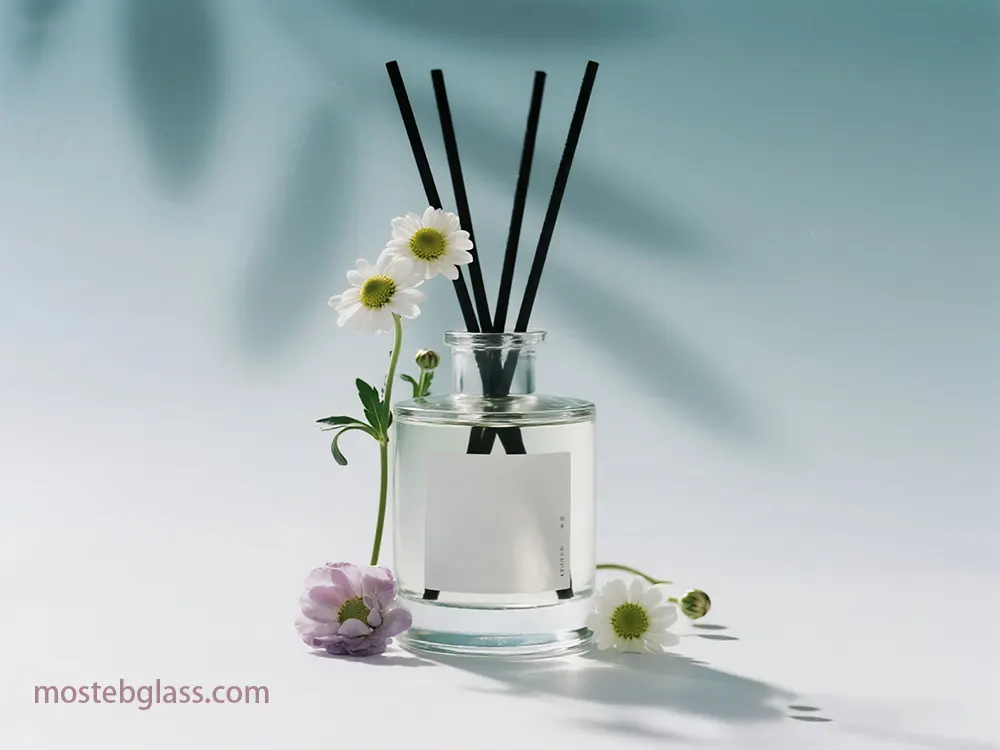
YSL Beauty’s Libre fragrance
claims gold foil, sharp lines and a fabricated glass bottle with rich texture, symbolizing drama and collapse.
Premium skincare brands often use bottles of vibrant tones and matte cap to reflect both luxury and functionality, such as vitamin C lines.
These examples show how decorative glass jars, thoughtful design and finishing techniques, become integral to the story of a brand, resonating deeply with consumers.
4. Customer travel elevated: from unboxing to demonstration
Customer travel is a series of travel touchpoints, and decorative glass jars significantly increase this experience in significant stages, from initial procurement appeal to the use of the product to the use of the product and the sensory pleasure of post-crop performance.
4.1. Initial Purchase Appeal and Shelf Standout
Glass packaging naturally expresses transparency, elegance, purity, and premium quality, allowing consumers to visually connect with the product and promote a perception of sophistication and refinement. The weight of a glass bottle is a powerful cue, with heavy bottles (such as whiskey, wine, champagne, a strong value for high quality, premium, worth a premium value. Glossy texture further incites the feelings of luxury.
Custom shapes and sizes also play an important role. Tall, thin glass design provokes elegance and specificity, suggests high-end materials. Figures such as hexagonal jars are gaining popularity for artisan products, offering a unique aesthetics that attracts attention. The use of color in glass packaging can provoke specific emotions; Tranwils suggest blues and muted greens relaxation, while vibrant red and dark purse express energy. In luxury packaging, colors such as black, white and gold are used to indicate reputation, modernity and ambiguity.
4.2. The Unboxing Moment: A Neurological Reward
Anboxing experience is a powerful emotional arc, which is taking initiative with anticipation and curiosity, progresses through excitement, and ends in satisfaction or despair. This process taps into deep psychological triggers, to receive a gift, and a strong emotional bond with a purchase decision, which is a strong emotional bond. Powered by human curiosity “fulfilling knowledge or understanding.”
Premium fittings and closures, such as magnetic classes or custom-designed hardware, are important here. They change the task of opening into a memorable, touch and emotional experience, indicate uniqueness and increase the perceived value of the product, making consumers feel that they are opening a precious gift.
4.3. Sensory experience during product use and post -purchase performance
Sensory experience is beyond unboxing. The “touch to touch” temperature of the glass bottle for juice or beer increases the perception of refreshing the temperature. Cutting or frost -sedentary touch quality, as previously discussed, provides a unique haptic reaction that strengthens quality and craftsmanship.
Post-purchase, decorative glass jars often transition to performance objects, expanding brand engagement. A beautifully designed jar, like a most -colored vase, becomes part of the consumer’s house decoration, which serves as a constant, subtle reminder of the brand and its values. This secondary use increases the loyalty of the brand and provides organic marketing, running through visual appearance.
- 4.4. Role of technology and privatization Neuromarcating techniques, including eye-tracking and EEG, provide deep insight into subconscious consumer behavior and packaging. Eye-tracking studies have shown that visual features such as colors, size, packaging materials, and logo consumer decision making and visual attention patterns significantly affect the pattern.
- Promotional reality (AR) is turning unboxing into interactive experiences. By scanning the QR code or markers on packaging, consumers can access the 3D product demo, interactive brand stories, tutorials, and information about the effort of origin or stability of the product. Brands such as Nike and Lego have successfully implemented AR to increase engagement and provide educational opportunities. Individual packaging, such as custom thank-u notes or QR code leading to exclusive content, feel more thoughtful and personal to unboxing experience, customers deepen connections and loyalty. This personalization is a strategic priority for many brands, which aim to build memorable moments that shop for engagement and repeat.
- 5. The Tangible Impact: Measuring Perceived Value, Loyalty, and Engagement Investing in decorative glass jars leads to average result, which affects the alleged product value, promotes brand loyalty, runs social media engagement and contributes to sales conversion.
- 5.1. Price and willing to pay The alleged product value in premium glass packaging is significantly enhanced, the major consumer to connect it with high quality and luxury, allowing a premium price to be perfect. This premium perception can increase consumers’ desire to pay up to 35% for premium packaging products. For example, a premium ghee brand saw a 30% increase in retail margin and after switching to the hexagonal glass jar from the plastic tub with a copper-finished cap.
- 5.2. Fostering Brand Loyalty
Glass packaging promotes the loyalty of the brand by constructing a trust through transparency and stability. Consumers are more likely to rely on transparent packaging, as it allows them to look inside the product, assuring them of quality. Glass is considered by 68% of consumers as the safest packaging material for food and beverages, and 3 out of 4 Europeans prefer glass for beauty, aroma, and medical products, which preserve the capacity of environmental friendship, health benefits (no chemical benefits). The brand uses glasses often see the high customer reactivity as the customer’s reactions to see the customer’s reactivity rates because the brands using the Glass often see the quality and the brand brand. They strengthen the loyalty by creating a relationship with the glass containers.
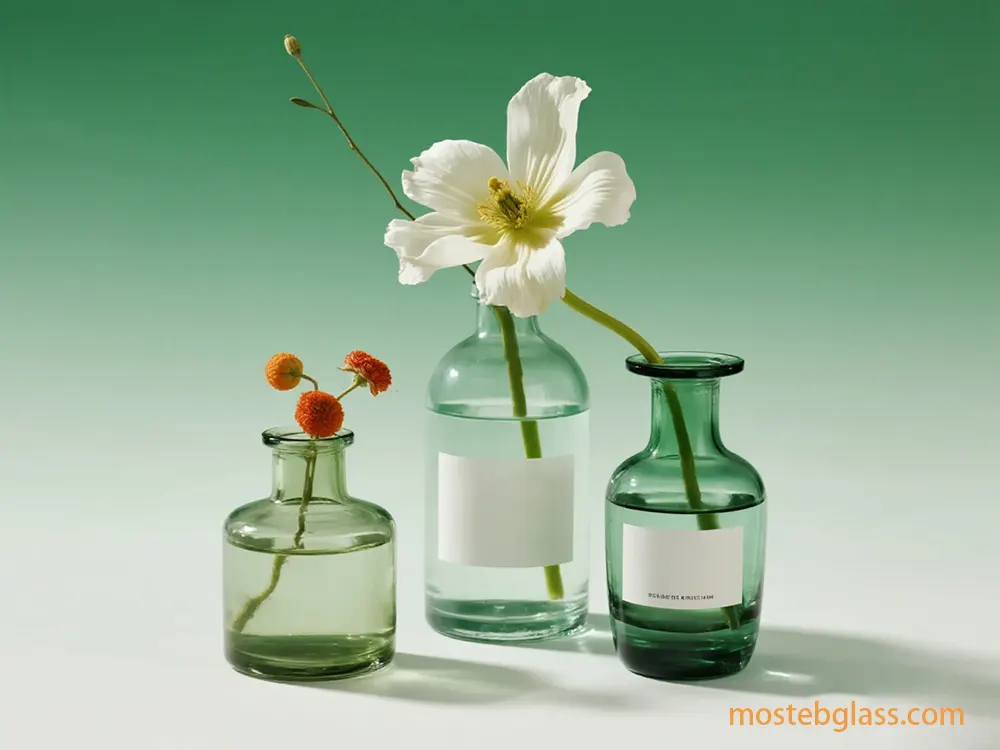
5.3. Driving Social Media Engagement and Sales Conversion
Custom and premium packaging attention is a strategic property in the economy, running social media shares and user-generated materials (UGC) 8385. A clear formula for virality is emerging: unique packaging → unboxing material → UGC → Reach → Conversion → Conversion 83. Environmental-masters packaging virality contributes to 8486. Eyeless interesting materials, such as touch finish, unexpected form factor, or interactive components with custom packaging, Instagram, Tikok, and Pinrests perform well on platforms such as algorithm prize novels and these elements make “subtle garlands of surprises” that want users to make captaincy and share.
The effective package design can achieve more ROIs than traditional advertising, with some research suggests that it can overcome the impact of three advertising campaigns and more than eight campaigners.-In-design packaging can increase in-store sales up to 30% (Nielseniq) and can contribute to better shelf visibility and market share.
5.4. Measuring Impact and Predictive Modeling
Various methods are employed to measure the effects of packaging, including consumer psychology studies, survey, focus group, and sensory tests. Sales volume, conversion rate, withdrawal rate, and market share such as qualified matrix are tracked, while qualitative KPI includes customer satisfaction and response. Effectiveness, customer satisfaction, sales performance, market share, brand recognition, customer retention rate (target above 70% annually), and Net Promoter Score (NPS).
Artificial Intelligence (AI) and Predictive Analytics are bringing revolution in the packaging design by predicting consumer reactions before the market launch. AI-operated emotion analysis equipment scans online discussions and reviews and identify public opinion and identify trends. Deep learning models predict purchasing behavior based on packaging characteristics, and generic adversarial networks (GANS) such as AI tools can create new designs. AI can conduct real-time A/B testing by following consumer interactions, allows for data-operated design decisions and reduce expensive redesign.
6. Sustainability as a Core Narrative: Reusability and Recyclability
In the era of enlarged environmental consciousness, re-purpose and recycling of decorative glass jars contribute significantly to the stability story of a brand, enhances the customer’s environment-conscious experience and promotes deep brand connections.
6.1. The "Say-Do Gap" and Consumer Barriers
Despite widespread environmental awareness, an important “Sai-Do Gap” is present in consumer behavior about re-purpose packaging. A survey in November 2023 showed that while 80% of consumers accept the importance of reducing single-use plastics, 78% actively do not choose products with refillable or reusable packaging. Primary obstacles for adoption are discomfort (difficulty in remembering for packaging/kurning/storing, hygiene, hygiene, and 67% realized that reusable packaging has more advance costs.
6.2. Glass as a Sustainable Choice: Perceptions and Challenges
Glass packaging is usually considered very positive for its stability, health benefits and ability to preserve the quality of the product. About 10 out of 8 European glass are seen as future fit packaging materials, combining it with recycling, health benefits and product protection 111. 65% rely on the quality of the product when packed in glass, and 7 in 10 trust recycled glass for food security.
However, the glass faces practical challenges. Its fragility and weight cost and fuel consumption makes it less suitable for delivery services. The failure of bottles during the reuse cycle is a concern for brands, and premium brands often prefer custom bottles on standardized people, which complicate large -scale refill plans.
6.3. Driver for adoption: Economic encouragement and infrastructure
Economic incentives are strong motivators. 58% of consumers who choose for reusable packaging refer to saving money as their main reason, and 71% will be reused if they get loyal points or discounts.
A major systemic barrier is widespread availability and lack of infrastructure. Most consumers (58%) disagree that they can purchase products in regularly reusable packaging, indicating that single-use options still dominate retail environment. The absence of in-store stations, home delivery services and efficient collection systems, accessible and convenient refill/returns, absence of infrastructure, considerable limitations.
6.4. Policy, education and collaborative solutions
Government’s policies and rules are important promoters to score again use systems. National policies including mandate, ban on single-use plastic, tax brakes, subsidy, and extended manufacturer responsibility (EPR) programs are important. The European Union’s packaging and packaging waste regulation (PPR), for example, the mandate, by 2030, 10% alcoholic and non-alcohol drinks should be available within a revaluation packaging.
Consumer education is also necessary to remove hesitation and confusion. There is a knowledge difference about the benefits and proper use of refillable systems, often means “reuse” with consumers. The expeditions that highlight environment and economic benefits, simplifying instructions, and myths that spread myths are important.
Successful refill programs often include strong brand engagement, technology and cooperation. Examples include the subscription model of Myro Deodorant, in-store refill station of body shop, and loop partnership. Loop partnership for glass packaging.
The global refillable packaging is estimated to increase to a great extent in the market, which is inspired to increase circular-economy rules, supply-chain cost pressures, and consumer stability preferences. Nevertheless, the environmental impact of reusable packaging systems is highly dependent on high return rates and efficient washing processes, which must be considered in life cycle assessment (LCAS).
7. Conclusion and Future Outlook
Decorative glass jars are more than simple containers; They are strategic assets that deeply affect brand identity, consumer perception and market success. From their ability to separate brands through custom design and touch, for their role in preparing compelling narratives and enhancing customer travel, glass jars provide a unique mix of aesthetics, functionality and stability. The alleged value, brand loyalty, and tangible effects on social media engagement outline their significant importance in modern branding.
Further, the future of decorative glass packaging is ready for exciting innovations, inspired by technological progress and developing consumer demands.
7.1. Emerging technologies and speculative trends
IOT Integration:
Smart Glass Packaging will integrate rapid IOT technologies such as QR code, NFC tag and RFID. These will provide interactive experience to consumers, real-time product information (eg, individual skincare tips from NFC-competent jars), and enable real-time tracking and authentication in the supply chain, important for product integrity and inventory management.
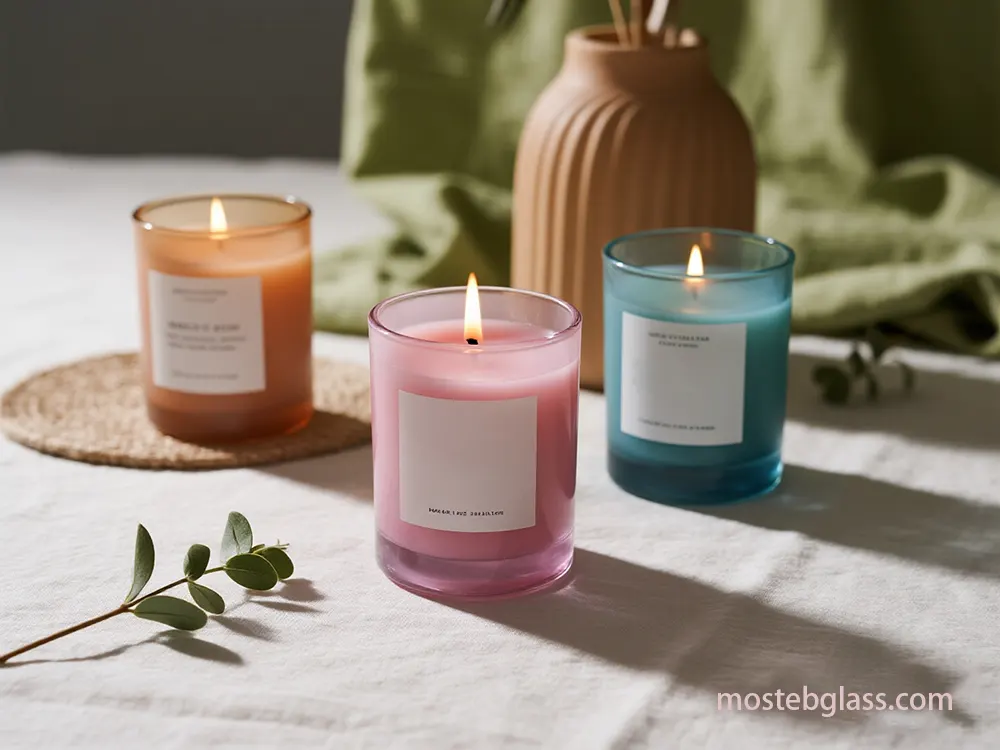
Dynamic and Interactive Labeling:
Labels will develop beyond stable information. QR code will link AR experiences, recipes, or brand stories.
Augmented Reality (AR) for immersive engagement:
AR will convert packaging into an interactive marketing tool. By scanning packaging, consumers will use 3D materials, product performance, tutorials and virtual tri-on experiences, increase brands loyalty and engagement. The AR Packaging Market is estimated to reach more than US $ 510.0 million by 2030.
Personal and adaptable glass designs:
Consumer-powered by consumer demand for unique experiences, will enable hyper-parsonalized glass packaging on the AI-operated design tool. These devices can generate creative concepts, optimize structural designs, and predict market trends, causing custom design for limited versions or individual preferences to be more inexpensive and efficient.
Advanced materials and manufacturing:
Innovations will include light glass options to reduce shipping costs and carbon emissions, as well as temporary glass or hybrid content for increased durability. Antimicrobial glass coatings with silver ions are being developed to prevent bacterial and viral growth.
Anti-counterfiting measures:
NFC tags and RFIDs will be rapidly embedded in packaging to increase security through certification and traceability, allowing consumers to verify the authenticity of the product and allow the products to scan before the factory. Reverse charging module.
Smart Glass (speculative):
Mainly for Windows, the underlying polymer scattered liquid crystal (PDLC) technology can be adapted for decorative packaging elements in switchable smart glass. This will allow the glass to switch to the frost immediately, providing energy efficiency by blocking dynamic privacy, projection capabilities and even UV rays.
7.2. Feasibility, cost and consumer acceptance
The global glass packaging market is expected to grow, indicating the desire to invest in these innovations. Smart smart technology involves the cost, the AI tool is noted to reduce the cost and time of the design. The demand for consumer for transparency, stability, and privatization remains higher, which is as well as an increase in the quality of the product. Engagement and loyalty.
7.3. Active ideas and opportunities
Moral implications of data collection:
As smart packaging collects more data, brands should address informed consent, data security, data minimalization, algorithm bias, transparency and accountability. Compliance with rules like GDPR will be paramount.
Energy requirements and permanent production:
The production of glass is energy. While smart glass consumes electricity, the wider trend in smart packaging aims to adapt the use of energy in construction and supply.
- Standardization for reuse: In fact, for the scale of reusable glass packaging, the industry-wide standardization of container designs will be important, to balance brand discrimination with collections, washing and refilling practicalities. This will require collaborative efforts between brands, manufacturers and policy makers.
- The “sensory signature” of the closure: While the functionality is improving, especially a specific opening is an unused opportunity to design the closure for sound or feel, which creates a unique “sensory signature” that confirms the brand identity. This luxury market can be a subtle yet powerful discrimination.
- The trip to the decorative glass jar, from a simple container to a sophisticated brand ambassador, is far from finishing. With constant innovation in design, materials and smart technologies, these ships will be at the forefront of creating memorable brand experience and running permanent consumer options. Wholesale Diffuser Bottles
- Wholesale Glass Vases Latest Insights
- Emerging Trends in Glass Blown Ornaments for Holiday Collections: 2026 and Beyond Comment
- Submit your opinion get a free quote
- Complete our quote request form or email us at to receive a customized quote from our product specialists.
Company
Phone/Whatsapp
Select a product
- glass candle jars Reed Diffuser Bottle
- glass vases Quantity
- contact our Product Expert Send us a message freely if you have any questions. We’ll get back to you within 30 minutes via email at
- , and we’ll adhere to the privacy policy to protect your information. full name
email adress




